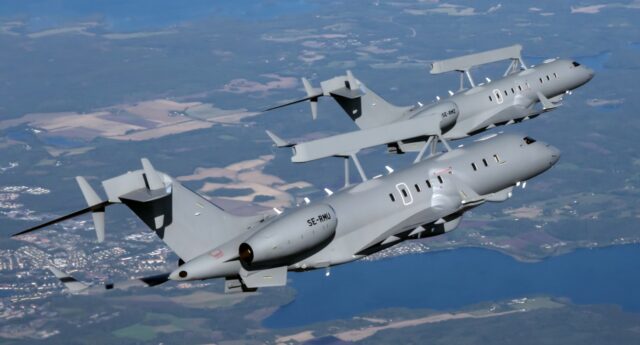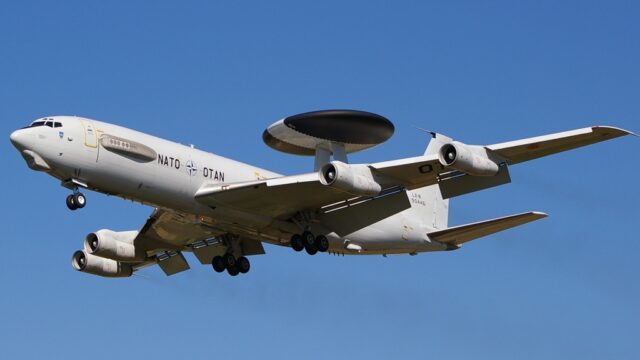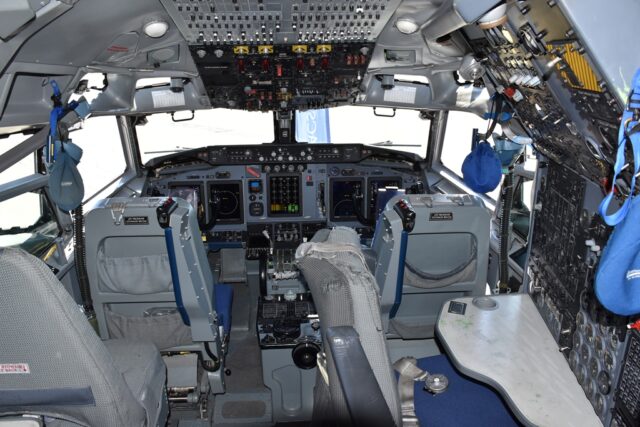👽GLOBALEYE POTENCJALNYM NASTĘPCĄ E-3 SENTRY W NATO In response to an inquiry from the NATO Support and Procurement Agency regarding the possibility of obtaining early warning and control aircraft, Saab presented an offer based on the GlobalEye multi-role early warning aircraft. The goal of the Alliance Future Surveillance and Control program is to select the successors of the E-3A Sentry aircraft , commonly known as AWACS, which are currently in service . The E-3As are to be retired after fifty years of service around 2035.
The AFSC program was initiated in February 2017 with a study phase, during which technical assumptions for future early warning aircraft were developed. The technical solutions present on the market and those under development as well as the legitimacy of the concept of creating a system of systems covering air, land and sea reconnaissance means exchanging data were analyzed. This phase of the program ended in December 2018. In the next stage, NSPA signed contracts with selected enterprises for the implementation and presentation of detailed technical concepts of the proposed solutions.
The presented Saab offer is the result of these analyses. The underlying GlobalEye system is not described by the manufacturer as only an early warning and command aircraft, but as a multi-role reconnaissance system ( swing-role surveillance system ), because in addition to detecting flying and sea targets, it is also capable of detecting land targets. The Bombardier Global 6000 business jet was selected as the platform for this system, offering adequate fuselage volume, engine power and a flight endurance of up to eleven hours.

A pair of GlobalEyes over Sweden.
(Saab)
The heart of the system is the Erieye ER radar, offering a detection range of over 600 kilometers. It is built of transceiver modules using gallium nitride (GaN). The aircraft is also equipped with an under-fuselage Selex ES Seaspray 7500E active electronic phase-scanning radar. It is used to detect sea and land targets, it has, among others, GMTI operating modes (It is used to detect sea and land targets, it has, among others, GMTI ( ground-moving target indicator ) and SAR ( synthetic aperture radar . Other mission equipment includes, among others, the FLIR Systems Star Safire 380HD observation head, tactical data exchange terminals in accordance with Link 11/16/22 standards, a friend-foreign identification system, ADS-B aircraft transponder signals receiver and AIS receiver for automatic ship identification systems.
You can read more about Swedish machines in our article: Swedish Erieye and GlobalEye Early Warning Aircraft
“Saab is a proven and trusted industrial partner for NATO, with operations in more than two-thirds of the countries belonging to the alliance,” said Carl-Johan Bergholm, Head of Reconnaissance at the Swedish company. – Our solutions, including GlobalEye, are designed from scratch to be compatible with NATO requirements. I am confident that we can offer key capabilities that will strengthen NATO and benefit member states.
NATO AWACS
NATO recognized the need for early warning aircraft as early as the 1960s, and it was reinforced in the following decade with the introduction of MiG-27 strike aircraft into service in the Soviet Union. Fast and flying at low altitude, Flogger Ds could attack most West German airfields without warning. Ordinary ground radar stations were not able to detect them, which was confirmed experimentally during exercises with NATO aircraft flying at low altitudes. The radar, placed on the plane flying at an altitude of about 10 kilometers near the border with the German Democratic Republic, gave about half an hour to react during a Soviet attack.

E-3A Sentry belonging to NATO.
(Maciej Hyps, Konflikty.pl)
The contract for eighteen E-3A Sentry aircraft was signed in 1978. All European NATO countries contributed to the costs, except for Great Britain, which at that time was developing its own capabilities of this type on the basis of the Nimrod AEW.3 aircraft, and which later also bought the E-3D. The first aircraft was delivered to the Geilenkirchen base in West Germany on February 24, 1982. Since the planes were to belong to the entire alliance, and not to a specific country, it was decided that they would be registered in a country that does not have its own air force - Luxembourg. Deliveries were completed in 1985.
For the purposes of the aircraft, a NATO Airborne Early Warning (NAEW) unit was formed, recruiting pilots and guidance controllers from all NATO countries. Geilenkirchen in Germany is the main base, while Konya in Turkey, rland in Norway, Trapani in Italy and Aktion in Greece have been adapted as forward operating bases.
The aircraft were delivered in the Block 10 version with the Westinghouse AN/APY-2 radar, also adapted to track sea targets. The radar has a range of over 400 kilometers and can simultaneously track up to 600 targets. Operators can guide their own fighters to sixty targets simultaneously. According to the contract, Boeing supplied only aircraft with radars, and the remaining avionics and specialist equipment was produced by European industry. In the mid-1980s, the aircraft were upgraded to the Block 25 standard, which involved the installation of five additional UHF radios. In the years 1992–1999, another modernization was carried out, including the installation of the Link 16 tactical data exchange link, interference-resistant UHF radios, color monitors in the operator consoles and electronic warfare means, as well as increasing the computer memory.

The cockpit of the upgraded E-3A.
(Maciej Hyps, Konflikty.pl)
The next modernization (Final Lifetime Extension Programme) was carried out in 2015–2018. Fourteen aircraft were modernized (the remaining four were withdrawn from service), equipping them with a digital cockpit and modernizing the avionics, adapting it to current and future requirements of air traffic regulations. On the main panel, the 1970s analog clocks and gauges have been replaced by five multi-function color digital monitors. Pilots can freely configure them: choose which engine, pilot and navigation data should be displayed. The first NATO AWACS was being upgraded at Boeing's facility in Seattle and delivered in November 2016. The remaining thirteen aircraft underwent modernization in Manching, Germany. Thanks to this, planes will be able to fly until 2035.
https://www.konflikty.pl/aktualnosci/wiadomosci/globaleye-nastepca-e-3-sentry-nato/